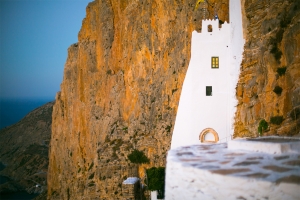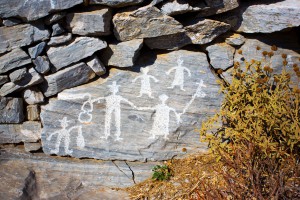Amorgos lies between Naxos and Astypalaia on the eastern end of the Cyclades. It has an area of 121 sq. km., a coastline of 112 km. and a population of 1,800. It is a mountainous island and has two small plains around its harbors, Aigiali to the north and Katapola. It has the most pronounced features of any of the Cyclades because of the sheer cliffs along the coast and the barren soil.
Its capital is at Chora, above Katapola, and to the south is Arkesini. There are also many smaller settlements on the island, covering its whole extent, and nature has endowed Amorgos with some of the most beautiful and imposing landscapes in the Cyclades, both along the sea, such as at Mouros and Agia Anna and in the mountains such as at Mt.Kroukelos the highest peak on Amorgos (821 m.) on its northern end.
Amorgos has been inhabited since approximately 4,000 B.C. as shown by the finds on Mountoulia hill which rises above the harbor of Katapola. The 3rd millennium B.C. was a very important time for Amorgos as the Cycladic civilization had spread to the island. At the beginning of the 2nd millennium B.C., however, it was supplanted by the Minoan.
This was the period when Minoa, the mythical resort of King Minos, would be created and thrive on Mountoulia hill. This period was followed by the Mycenean civilization and after that Amorgos would be colonized by the residents of Naxos who would found Arkesini. In the 7th century B.C. the Ionians from Samos would come to the island, to the area around Minoa, as well as colonists from Miletus who founded Aiyiali. Starting in the 6th century B.C. Amorgos experienced significant economic and intellectual advances as it exploited its geographical position in the best possible way.



